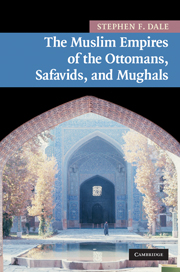Book contents
- Frontmatter
- Contents
- List of illustrations
- List of maps
- Preface
- Languages and transliteration
- Introduction
- 1 India, Iran, and Anatolia from the tenth to the sixteenth century
- 2 The rise of Muslim empires
- 3 The legitimacy of monarchs and the institutions of empires
- 4 The economies around 1600
- 5 Imperial cultures
- 6 Golden ages: profane and sacred empires
- 7 Imperial culture in the golden age
- 8 Quests for a phoenix
- Conclusion
- Glossary
- Dynastic lists
- Bibliography
- Index
Conclusion
Published online by Cambridge University Press: 05 October 2014
- Frontmatter
- Contents
- List of illustrations
- List of maps
- Preface
- Languages and transliteration
- Introduction
- 1 India, Iran, and Anatolia from the tenth to the sixteenth century
- 2 The rise of Muslim empires
- 3 The legitimacy of monarchs and the institutions of empires
- 4 The economies around 1600
- 5 Imperial cultures
- 6 Golden ages: profane and sacred empires
- 7 Imperial culture in the golden age
- 8 Quests for a phoenix
- Conclusion
- Glossary
- Dynastic lists
- Bibliography
- Index
Summary
The world that was lost
During the two centuries between 1722 and 1923 the Safavid, Mughal, and Ottoman empires withered and collapsed. The charisma and dynamism of these dynasties' early rulers had atrophied and largely evaporated by the time Afghans entered Isfahan, Nader Shah sacked Delhi, and the British and French landed troops in Istanbul at the end of the First World War. Apart from their architectural monuments, exquisite painting, and memorable poetry, dynastic collapse left markedly different legacies in the territories of these empires.
Iran
In Iran, the Safavids, the weakest of all three dynasties, left the most profound and enduring legacies: the resurrection of Iranian political identity by the establishment of a state, called Iran, in the historic heartlands of the Achaemenid and Sasanian empires; the patronage of an identifiably Persian literary and artistic culture; the equation of the Iranian state with Shi‘i Islam and the conversion of the formerly majority Sunni population to Twelver Shi‘ism; and the institutionalization of a powerful, semi-autonomous, Shi‘i clergy. The institutionalization of an Iranian Shi‘i ‘ulama had unintended consequences, as many clerics dismissed the legitimacy of monarchs or political leaders apart from the Twelfth Imam or his earthly representatives, the Ayatollahs, the senior Shi‘i clerics or mujtahids who were, like the seventeenth-century Lebanese scholar al-Karaki, competent to engage in ijtihad or interpretation of Shi‘i theology.
- Type
- Chapter
- Information
- The Muslim Empires of the Ottomans, Safavids, and Mughals , pp. 288 - 292Publisher: Cambridge University PressPrint publication year: 2009



